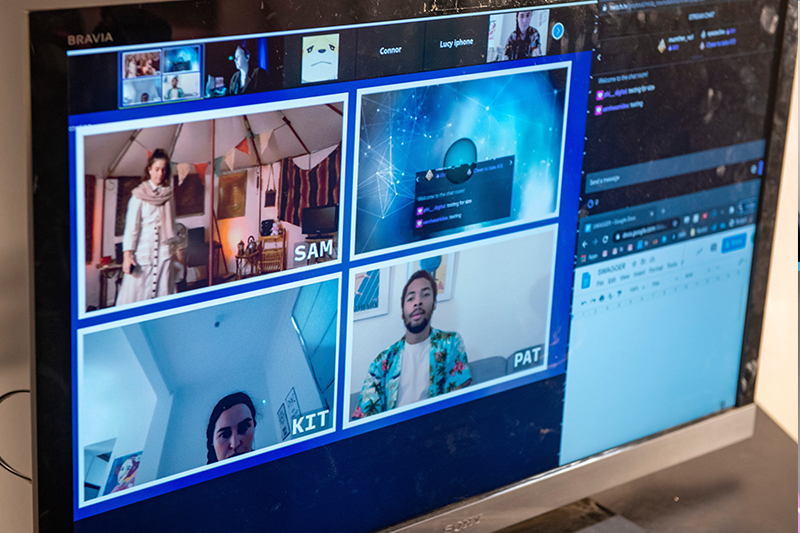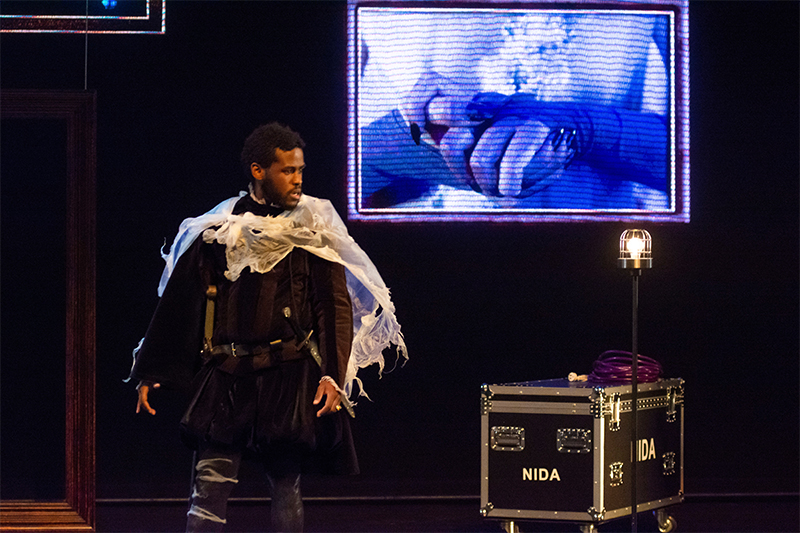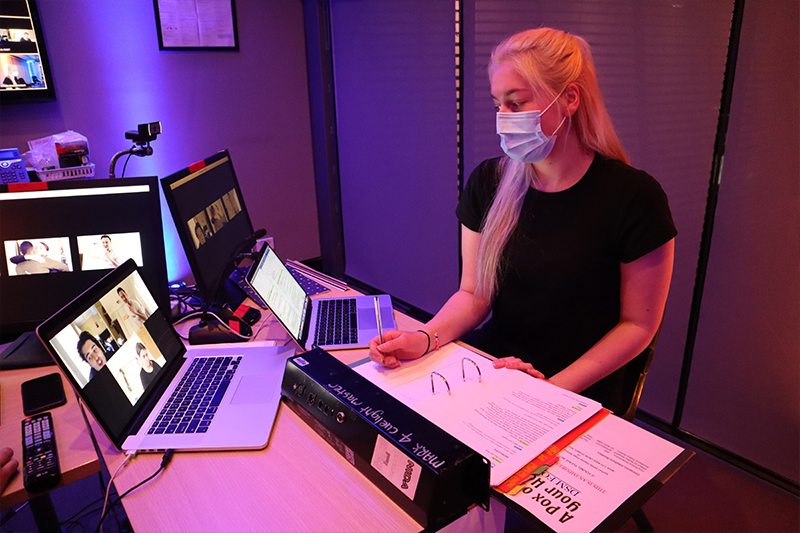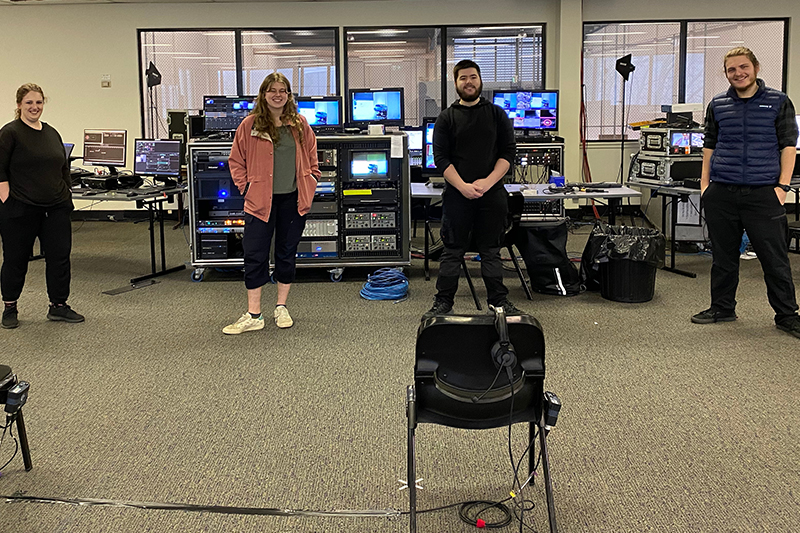
Photo: Roundabout online.
NIDA’s Digital Theatre Festival in August challenged and reinvented online storytelling, using multiple platforms to interact with audiences in new and inventive ways.
Working with international and Australian directors who are known for their creative digital expertise, the season of six world premieres were made entirely for an online audience.
For the Bachelor of Fine Arts (Technical Theatre and Stage Management) students and tutors working in technical roles and as Project Managers on the productions, the Festival meant learning new digital skills in cinematography, editing, sound recording and lighting.
‘The Festival represented a hugely innovative leap into new mediums and methods for theatrical storytelling,’ said NIDA Director, Centre for Technology, Production and Management, Graham Henstock. ‘Embracing this innovation introduced a unique set of challenges for Technical Theatre and Stage Management students.
‘While they are taught how to utilise many different technologies, all the students needed to quickly identify, experiment and achieve proficiency with equipment and processes that they had not encountered before.’
‘The fact that they adapted so quickly and successfully delivered six technically complex productions is a testament to their ingenuity, resilience and talent. I am enormously proud of the work that they produced.’
Roundabout: ‘Behind one mountain is often another’

Photo: Roundabout online.
Daniel Herten is a third-year Bachelor of Fine Arts (Technical Theatre and Stage Management) student and was Audio-Visual Designer, Technical Supervisor and Editor on Roundabout.
The live audience were active co-creators on the Twitch channel, used by video-gamers, and determined the course of action. Even over six performances, not all possibilities were exhausted.
‘A big challenge for us was learning to communicate with our international guest director, Sean Stewart, who was in Los Angeles during our technical rehearsal sessions. We had to completely overhaul our working hours during the pre-production and show run weeks,’ said Daniel.
The technical team spent weeks preparing plans and layouts around video system schematics, finding reliable ways to move data across the internet and learning about audio latency.
‘At one stage we started getting a bit hysterical as a new video system schematic was coming out at about every two days,’ said Daniel. ‘We had to apply knowledge of software development, coding and gaming to get the show off of the ground. The process was full of compromise and we all went into it with the understanding that much of what we were trying was uncharted for us and experimental.
‘This mindset resulted in discussions where anyone, regardless of their titled role, could pitch in and suggest new angles to explore in the various aspects of the show such as technical design or even the script.’
Daniel said that the difficult part about putting this show together was planning for changes and unforeseen challenges. ‘Because we were trying to do things we had not done before, such as live streaming video and having live animation, the actual infrastructure that we built through our system to facilitate these components of the show had to be bigger than initially required incase we wanted to add or change things later.
‘We ended up making many changes close to the performances as we discovered things that we could not have identified about the show when rehearsing in our own homes due to COVID.’
Daniel said that Sean often spoke to the students about the ‘minimal viable product’ and developing aspects of the show in stages of functionality to reduce the risk of attempting something that was not feasible.
‘I quickly discovered that when working in new territory, as Sean explained “behind one mountain is often another”. After starting to take on this mindset in my work, I have become a much better audio-visual designer and my team has improved in their ability to manage a very complicated technical system.’
Theatrical monologues meet live streaming

Ghost Lights was an innovative integration of theatre and digital media in performance, directed by theatre and new media artist Katy Alexander, who was resident director at California Institute of Arts and trained with Robert Lepage and The Builders Association (NYC).
It began with theatrical characters from Shakespeare, Pirandello, Ibsen and NIDA’s Head of Writing Dr Stephen Sewell, delivering iconic monologues in a short film.
NIDA Bachelor of Fine Arts (Technical Theatre and Stage Management) students and Project Managers Mali Tauro-Cesca and Morgan Moroney explained that to create these films, the technical team had to experiment in lighting for film, portable sound recording, and learn new skills in cinematography and editing.
The short films were then uploaded to social media where the online audience could interact with and learn about the characters they would later meet in a live show. The stage play was streamed live on YouTube from an empty Parade Theatre.
The overall effect is a live, digital experience that the audience has interacted with throughout the entire process.
Three-part show over Zoom

Written and directed by leading experimental Australian performance, theatre and installation artist Deborah Pollard, A Pox on Both Your Houses was a three-part show broadcast on three separate nights over Zoom.
NIDA Bachelor of Fine Arts (Technical Theatre and Stage Management) students Fiona Lloyd Harding (Technical Designer) and Isaac Barron (Technical Systems Supervisor) explained that while appearing simple for the audience, the show contained over 250 video cues, 100 sound cues and operators viewing up to six screens at a time.
The goal was to make this amount of technical production entirely invisible to the audience. The technical team Fiona Lloyd Harding, Isaac Barron and Jodi Rabinowitz created a system using Open Broadcast Software (OBS), Team viewer and Zoom to modify how the cast appears on screen.
This system allows the team to position the cast on the screen and overlay video content even though the actors are located in four different locations. With green screens installed, over Zoom they called in to the system located at NIDA.
The audio system allows for both the cast and audience to hear the score and sound effects. It also allows for the Stage Management Nathan Sandy, and Sophie Jones to talk to the cast and audience while being on a Zoom call with both.
Live broadcast from four sets blended with pre-recorded film

Lunacy was written and directed by NIDA Directing alumnus and multi-media writer Pierce Wilcox. It is technically and logistically complex for several reasons, explains NIDA Bachelor of Fine Arts (Technical Theatre and Stage Management) Thomas Houghton who has a staggering eight roles on the show -Technical Director, Swing SM, LX Designer, HLX, VX/SND System Des/Sup, Human Counterweight, Archive content designer, Assistant Archive content writer, and Website Developer.
The show begins asking the audience to explore a custom-designed website. The second part combines film and theatre, broadcast live from a huge warehouse in Alexandria.
The show is shot live with eight cameras which send a feed to a central position, where a Video Mixer, Lighting and Audio Mixers, Remote Camera, Media Server Operators and Show Caller control it.
The video content is created to a standard definition PAL format which gives it an older ‘broadcast signal’ feeling. The show is then streamed for the audience to view.
Feeling inspired? Find out more about studying Technical Theatre and Stage Management at NIDA here.
